This ebook outlines 7 reasons to consider an in situ permeable reactive barrier (I-PRB) to treat groundwater contaminants. If designed intelligently and installed correctly, I-PRBs can be a highly cost-effective and customizable remediation tool that environmental practitioners can use to achieve cleanup goals.
eBook highlights:
- I-PRBs are a smart solution when longevity and reducing risk to sensitive receptors are concerns.
- I-PRBs can treat a wide range of contaminants.
- These barriers can be successful enough to decommission pump and treat systems and allow site owners to pursue complete regulatory site closure.
- New I-PRB technologies designed for ease of installation allow for reduction of the carbon footprint associated with construction time and equipment.
I-PRBs are permeable treatment zones designed to passively intercept and treat contaminated groundwater. They are called permeable because, unlike traditional barriers such as sheet piling (i.e. Waterloo Barriers) slurry walls (i.e. cement and bentonite), they allow water to flow through while treating dissolved phase contaminants.
Complete the form on this page to download the free ebook.


